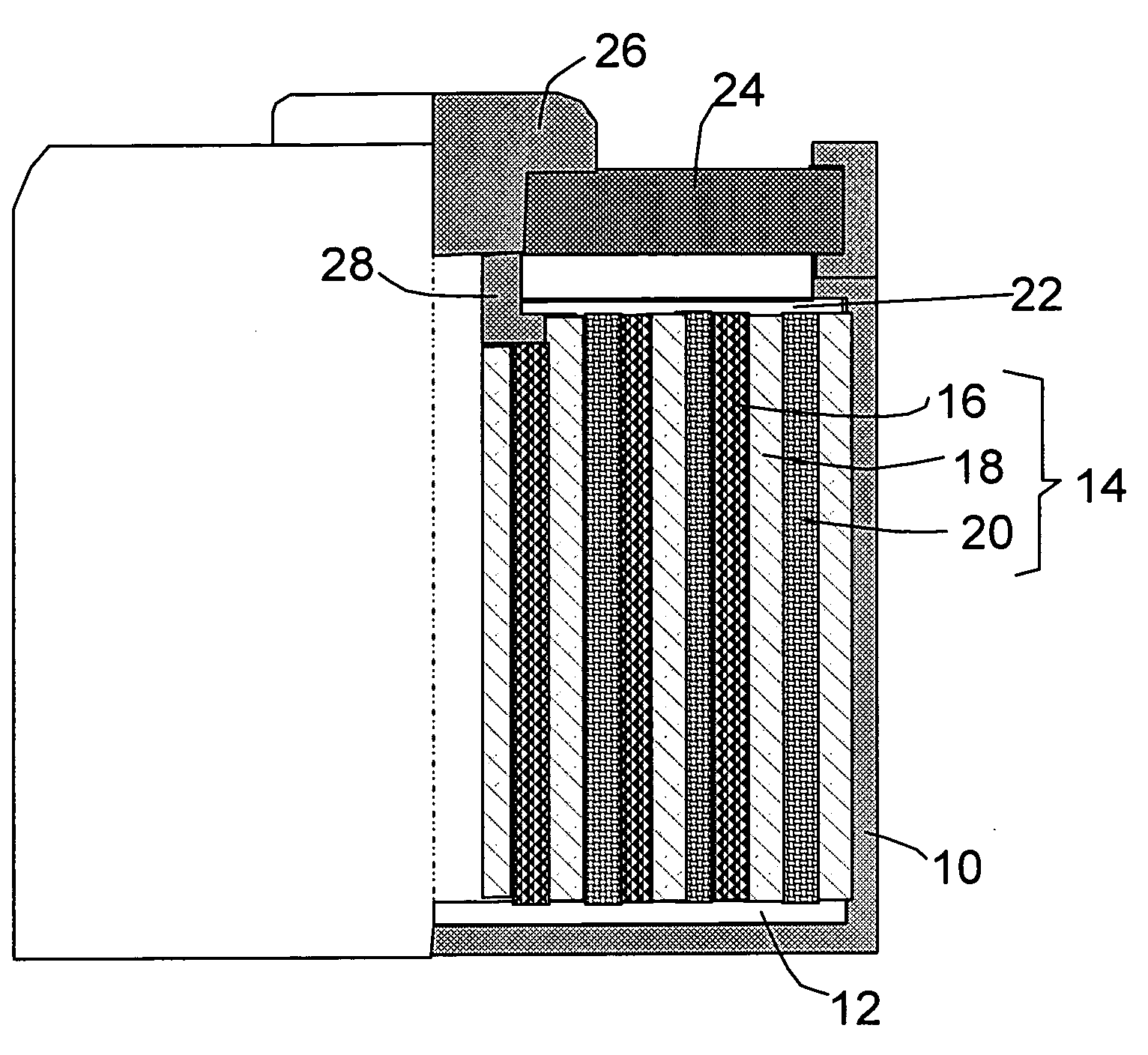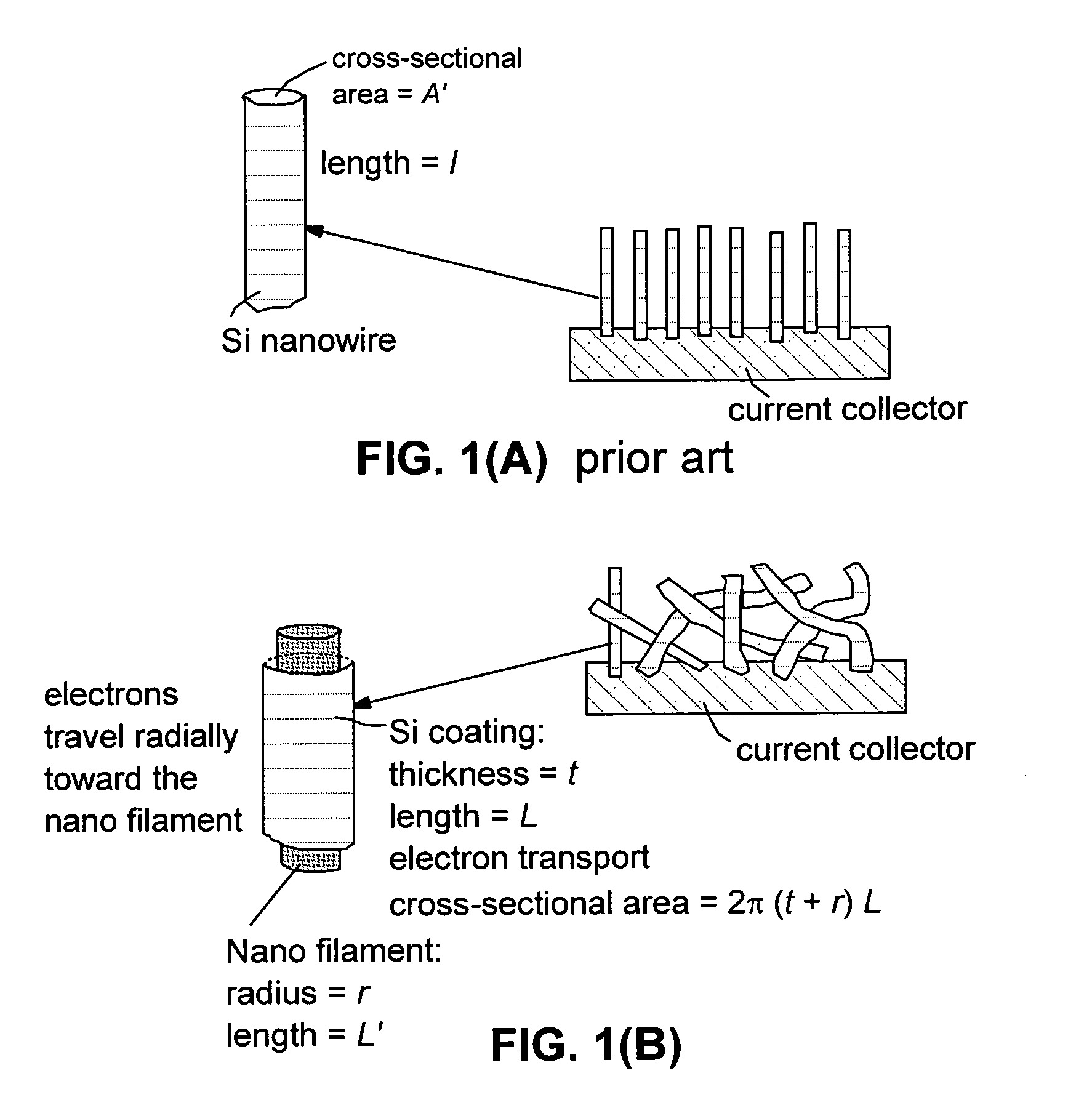Method of producing hybrid nano-filament electrodes for lithium metal or lithium ion batteries
a lithium metal or lithium ion battery technology, applied in the direction of sustainable manufacturing/processing, cell components, physical treatment, etc., can solve the problems of shortening the charge-discharge cycle life, shortening the reversible capacity of art composite electrodes, and reducing the reversible capacity. achieve the effect of significant reducing internal energy loss or internal heating
- Summary
- Abstract
- Description
- Claims
- Application Information
AI Technical Summary
Benefits of technology
Problems solved by technology
Method used
Image
Examples
example 1
Conductive Web of Filaments from Electro-Spun PAA Fibrils
[0137]Poly(amic acid) (PAA) precursors for spinning were prepared by copolymerizing of pyromellitic dianhydride (Aldrich) and 4,4′-oxydianiline (Aldrich) in a mixed solvent of tetrahydrofurane / methanol (THF / MeOH, 8 / 2 by weight). The PAA solution was spun into fiber web using an electrostatic spinning apparatus schematically shown in FIG. 3. The apparatus consisted of a 15 kV d.c. power supply equipped with a positively charged capillary from which the polymer solution was extruded, and a negatively charged drum for collecting the fibers. Solvent removal and imidization from PAA were performed concurrently by stepwise heat treatments under air flow at 40° C. for 12 h, 100° C. for 1 h, 250° C. for 2 h, and 350° C. for 1 h. The thermally cured polyimide (PI) web samples were carbonized at 1,000° C. to obtain Sample c-PI-0 with an average fibril diameter of 67 nm.
example 2
Conductive Web of Filaments from Electro-Spun PAN Fibrils and NGP-Containing PAN Fibrils
[0138]Suspension solutions were obtained by first preparing two solutions (A=solvent+NGPs and B=solvent+polymer) and then mixing the two solutions together to obtain the suspension solution. In the case of NGP-PAN fibril, the solvent used was N,N,-dimethyl formamide (DMF). For the preparation of Suspension A, the NGPs were added to a solvent and the resulting suspensions were sonicated to promote dispersion of separate NGPs in the solvent with a sonication time of 20 minutes. Suspension solution B was obtained by dissolving the polymer in the solvent with the assistance of heat (80° C. for DMF+PAN) and stirring action using a magnetic stirrer typically for 90 and 30 minutes, respectively. Suspensions A and B were then mixed together and further sonicated for 20 minutes to help maintain a good dispersion of NGPs in the polymer-solvent solution. An electrostatic potential of 10 kV was applied over ...
example 3
Chemical Vapor Deposition of Si on Conductive Webs for the Preparation of an Anode Configuration in Partnership with a Presently Invented Cathode
[0141]The CVD formation of silicon films on several webs prepared in Examples 1 and 2 were carried out using a mixture of monosilane (SiH4) and hydrogen gas. The process was performed between 500° C. and 800° C. with a silane partial pressure of 0.2 to 10 mbar to a total pressure of the silane-hydrogen mixture of 100 to 990 mbar. The growth rates were found to vary from approximately 55 nm / hour to 10 μm / min.
[0142]Hexachlorodisilane (Si2Cl6) is a silicon halide dimer that is an excellent alternative to silane (SiH4) and mono-silicon chlorides (SiH2Cl2) as a source for chemical vapor deposition (CVD) of silicon, silicon nitride, silicon dioxide, and metal silicide films. Si2Cl6 is a non-flammable liquid which, due to its room temperature vapor pressure of 4 mm, can be conveniently transported to a CVD reactor by passing H2 or an insert gas th...
PUM
| Property | Measurement | Unit |
|---|---|---|
| Temperature | aaaaa | aaaaa |
| Temperature | aaaaa | aaaaa |
| Length | aaaaa | aaaaa |
Abstract
Description
Claims
Application Information
 Login to View More
Login to View More - R&D
- Intellectual Property
- Life Sciences
- Materials
- Tech Scout
- Unparalleled Data Quality
- Higher Quality Content
- 60% Fewer Hallucinations
Browse by: Latest US Patents, China's latest patents, Technical Efficacy Thesaurus, Application Domain, Technology Topic, Popular Technical Reports.
© 2025 PatSnap. All rights reserved.Legal|Privacy policy|Modern Slavery Act Transparency Statement|Sitemap|About US| Contact US: help@patsnap.com



